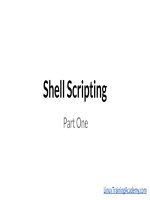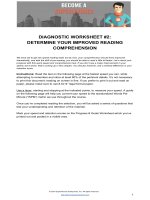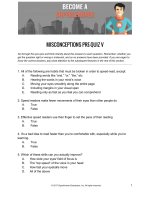080 call ret kho tài liệu training
Bạn đang xem bản rút gọn của tài liệu. Xem và tải ngay bản đầy đủ của tài liệu tại đây (636.13 KB, 53 trang )
CALL and RET
Assembly language programming
By xorpd
xorpd.net
Objectives
We will study the CALL and RET instructions.
We will see examples of using CALL and RET.
We will understand the stack’s meaning with
respect to function calls.
Example
A function that calculates the sum of a list of
numbers (dwords):
; Input: ecx – length of list.
;
esi – address of list.
; Output: eax – contains the sum.
;
sum_nums:
xor
edx,edx
next_dword:
lodsd
add
edx,eax
loop
next_dword
mov
eax,edx
Example (Cont.)
A function that calculates the sum of a list of
numbers (dwords):
; Input: ecx – length of list.
;
esi – address of list.
; Output: eax – contains the sum.
;
sum_nums:
push
edx ; Keep regs.
push
ecx
xor
edx,edx
next_dword:
lodsd
add
edx,eax
loop
next_dword
mov
eax,edx
pop
ecx ; Restore regs.
pop
edx
Example (Cont.)
Using sum_nums:
mov
esi,my_list
mov
ecx,LIST_LEN
call
sum_nums
; Exit the process:
push
0
call
[ExitProcess]
sum_nums:
push
push
xor
next_dword:
lodsd
add
loop
mov
pop
pop
ret
edx ; Keep regs.
ecx
edx,edx
edx,eax
next_dword
eax,edx
ecx ; Restore regs.
edx
Example (Cont.)
Using sum_nums:
mov
esi,my_list
mov
ecx,LIST_LEN
call
sum_nums
; Exit the process:
push
0
call
[ExitProcess]
sum_nums:
push
push
xor
next_dword:
lodsd
add
loop
mov
pop
pop
ret
edx ; Keep regs.
ecx
edx,edx
edx,eax
next_dword
eax,edx
ecx ; Restore regs.
edx
Example (Cont.)
Using sum_nums for two different lists:
mov
mov
call
mov
esi,my_list1
ecx,LIST1_LEN
sum_nums
edx,eax
mov
mov
call
mov
; ...
esi,my_list2
ecx,LIST2_LEN
sum_nums
ebx,eax
push
call
0
[ExitProcess]
sum_nums:
; ...
ret
Example (Cont.)
Using sum_nums for two different lists:
mov
mov
call
mov
esi,my_list1
ecx,LIST1_LEN
sum_nums
edx,eax
mov
mov
call
mov
; ...
esi,my_list2
ecx,LIST2_LEN
sum_nums
ebx,eax
push
call
0
[ExitProcess]
sum_nums:
; ...
ret
First call to sum_nums
Example (Cont.)
Using sum_nums for two different lists:
mov
mov
call
mov
esi,my_list1
ecx,LIST1_LEN
sum_nums
edx,eax
mov
mov
call
mov
; ...
esi,my_list2
ecx,LIST2_LEN
sum_nums
ebx,eax
push
call
0
[ExitProcess]
sum_nums:
; ...
ret
Second call to sum_nums
Example (Cont.)
Using sum_nums for two different lists:
mov
mov
call
mov
esi,my_list1
ecx,LIST1_LEN
sum_nums
edx,eax
mov
mov
call
mov
; ...
esi,my_list2
ecx,LIST2_LEN
sum_nums
ebx,eax
push
call
0
[ExitProcess]
sum_nums:
; ...
ret
How can ret know where to return?
Second call to sum_nums
CALL and RET
CALL arg
Call procedure
○ Push the address of the next instruction to the
stack.
○ 𝑒𝑖𝑝 ← 𝑎𝑟𝑔 (Jump to 𝑎𝑟𝑔).
RET
Return from procedure
○ Pop a dword 𝑥 from the stack.
○ 𝑒𝑖𝑝 ← 𝑥 (Jump to 𝑥).
The return address is kept on the stack!
Example – Simple calling
Simple calling and returning:
call
...
my_func:
...
ret
my_func
Example – Simple calling
Simple calling and returning:
...
call
...
my_func:
...
ret
my_func
????????
????????
Address growth
????????
????????
????????
????????
...
Example – Simple calling
Simple calling and returning:
...
call
...
my_func:
...
ret
my_func
????????
unoccupied
????????
esp
????????
????????
????????
????????
...
occupied
Example – Simple calling
Simple calling and returning:
...
call
...
my_func:
...
ret
my_func
????????
esp
unoccupied
0040200a
????????
????????
????????
????????
...
occupied
Example – Simple calling
Simple calling and returning:
...
call
...
my_func:
...
ret
my_func
????????
esp
unoccupied
0040200a
????????
????????
????????
????????
Next instruction’s address
...
occupied
Example – Simple calling
Simple calling and returning:
...
call
...
my_func:
...
ret
my_func
????????
esp
unoccupied
0040200a
????????
????????
????????
????????
...
occupied
Example – Simple calling
Simple calling and returning:
...
call
...
my_func:
...
ret
my_func
????????
unoccupied
0040200a
esp
????????
????????
????????
????????
...
occupied
Example – Nested calling
Nested calling:
call
...
func_a:
call
call
ret
func_b:
...
ret
func_c:
...
ret
func_a
func_b
func_c
Example – Nested calling
Nested calling:
call
...
func_a:
call
call
ret
Call graph
func_a
start
func_b
func_c
func_a
func_b:
...
ret
func_b
func_c:
...
ret
func_c
Example – Nested calling
Nested calling:
00402000
00402005
call
...
0040200d
00402012
00402017
func_a:
call
call
ret
00402018
00402019
func_b:
...
ret
0040201a
0040201b
func_c:
...
ret
func_a
...
????????
????????
func_b
func_c
????????
esp
????????
????????
????????
...
Example – Nested calling
Nested calling:
00402000
00402005
call
...
func_a
0040200d
00402012
00402017
func_a:
call
call
ret
????????
00402018
00402019
func_b:
...
ret
????????
0040201a
0040201b
func_c:
...
ret
...
????????
????????
func_b
func_c
esp
00402005
????????
...
Example – Nested calling
Nested calling:
00402000
00402005
call
...
func_a
0040200d
00402012
00402017
func_a:
call
call
ret
????????
00402018
00402019
func_b:
...
ret
????????
0040201a
0040201b
func_c:
...
ret
...
????????
func_b
func_c
esp
00402012
00402005
????????
...
Example – Nested calling
Nested calling:
00402000
00402005
call
...
func_a
0040200d
00402012
00402017
func_a:
call
call
ret
????????
00402018
00402019
func_b:
...
ret
????????
0040201a
0040201b
func_c:
...
ret
...
????????
func_b
func_c
esp
00402012
00402005
????????
...
Example – Nested calling
Nested calling:
00402000
00402005
call
...
func_a
0040200d
00402012
00402017
func_a:
call
call
ret
????????
00402018
00402019
func_b:
...
ret
????????
0040201a
0040201b
func_c:
...
ret
...
????????
00402012
func_b
func_c
esp
00402005
????????
...









